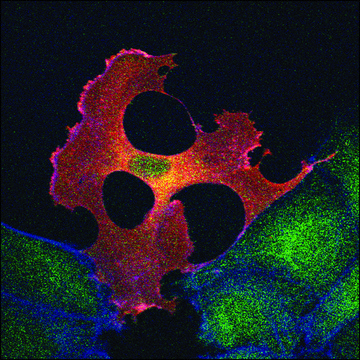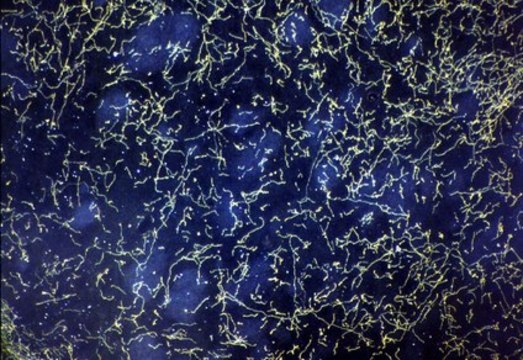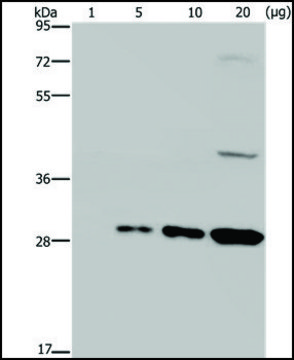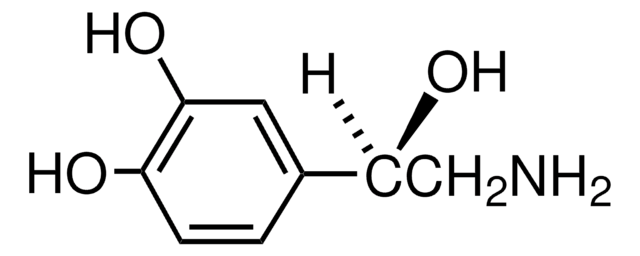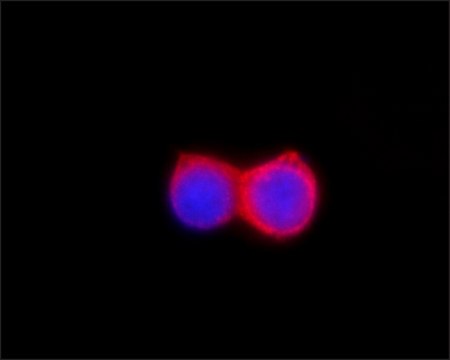SAB4200039
Anti-Serotonin Transporter (N-terminal) antibody produced in rabbit
~1.5 mg/mL, affinity isolated antibody, buffered aqueous solution
Sign Into View Organizational & Contract Pricing
All Photos(1)
Synonym(s):
Anti-5-hydroxytryptamine transporter, Anti-5HTT, Anti-HTT, Anti-OCD1, Anti-SERT, Anti-SLC6A4 solute carrier family 6, member 4
UNSPSC Code:
12352203
NACRES:
NA.41
Recommended Products
biological source
rabbit
Quality Level
conjugate
unconjugated
antibody form
affinity isolated antibody
antibody product type
primary antibodies
clone
polyclonal
form
buffered aqueous solution
mol wt
antigen ~83 kDa
species reactivity
human
concentration
~1.5 mg/mL
technique(s)
western blot: 1.5-3.0 μg/mL using SH-SY5Y cell lysates
UniProt accession no.
shipped in
dry ice
storage temp.
−20°C
target post-translational modification
unmodified
Gene Information
rat ... Slc6a4(25553)
General description
Solute carrier family 6 member 4 (SLC6A4), also known as 5-hydroxytryptamine transporter (5-HTT), is an integral membrane protein, encoded by the gene mapped to human chromosome 17q11.2. The encoded protein is a member of SLC6 gene family and is mainly expressed in brain and blood cells.
Application
Anti-Serotonin Transporter (N-terminal) antibody produced in rabbit has been used in western blot analysis and immunohistochemistry.
Biochem/physiol Actions
Solute carrier family 6 member 4 (SLC6A4) catalyzes the transport of neurotransmitter serotonin from the synaptic space into presynaptic neurons. It also plays a vital role in mood and anxiety regulation. Mutation on the gene might alter the expression of serotonin (5HT) in the synaptic cleft, which ultimately leads to schizophrenia. Allelic variations in the gene increases the risk of susceptibility to autism and rigid-compulsive behaviors.
The polymorphic promoter region of the serotonin transporter gene serotonin-transporter-linked polymorphic region (5HTTLPR), has been suggested to affect serotonin uptake and may play a role in the pathogenesis of depression, obsessive-compulsive disorder (OCD) and aggressive behavior.
Physical form
Solution in 0.01 M phosphate buffered saline, pH 7.4, containing 15 mM sodium azide.
Disclaimer
Unless otherwise stated in our catalog or other company documentation accompanying the product(s), our products are intended for research use only and are not to be used for any other purpose, which includes but is not limited to, unauthorized commercial uses, in vitro diagnostic uses, ex vivo or in vivo therapeutic uses or any type of consumption or application to humans or animals.
Flash Point(F)
Not applicable
Flash Point(C)
Not applicable
Regulatory Information
常规特殊物品
Certificates of Analysis (COA)
Search for Certificates of Analysis (COA) by entering the products Lot/Batch Number. Lot and Batch Numbers can be found on a product’s label following the words ‘Lot’ or ‘Batch’.
Already Own This Product?
Find documentation for the products that you have recently purchased in the Document Library.
Fluoxetine Increases the Expression of miR-572 and miR-663a in Human Neuroblastoma Cell Lines
Mundalil Vasu M
PLoS ONE, 11 (2016)
Influence of serotonin transporter promoter region polymorphisms on hippocampal volumes in late-life depression
Taylor WD, et al.
Archives of General Psychiatry, 62(5), 537-544 (2005)
Robert Schwamborn et al.
Journal of neurochemistry, 137(3), 423-435 (2016-03-01)
The serotonin transporter (SERT) is responsible for high-affinity serotonin (5-HT) uptake from extracellular fluid and is a prominent pharmacological target in the treatment of depression. In recent years, depression has also been linked to immune system activation. Inflammatory conditions can
Mahesh Mundalil Vasu et al.
PloS one, 11(10), e0164425-e0164425 (2016-10-08)
Evidence suggests neuroprotective effects of fluoxetine, a selective serotonin reuptake inhibitor (SSRI), on the developed neurons in the adult brain. In contrast, the drug may be deleterious to immature or undifferentiated neural cells, although the mechanism is unclear. Recent investigations
Mariko Nakamura et al.
Human psychopharmacology, 37(2), e2818-e2818 (2021-09-21)
The aim of this study was evaluation of the association between severity of pain and expression of total or ubiquitinated serotonin transporter (SERT) protein in patients with burning mouth syndrome and atypical odontalgia (BMS/AO), who were treated by duloxetine. Patients
Our team of scientists has experience in all areas of research including Life Science, Material Science, Chemical Synthesis, Chromatography, Analytical and many others.
Contact Technical Service